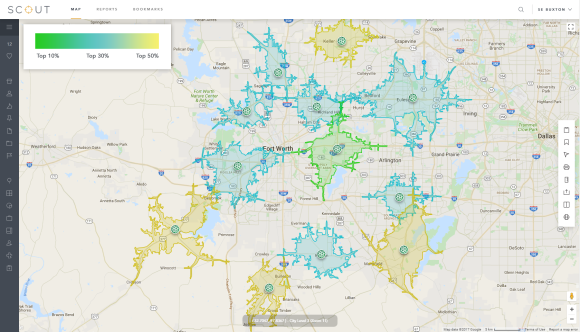A territory based business can be defined as one that offers a service within a territory that doesn’t rely on a traditional brick and mortar location (e.g. pest control, lawn services, cleaning services, etc.). This type of business lends itself to its own set of unique challenges and opportunities.
One difference between traditional retailers and territory based businesses is that these businesses do not having an established storefront in the community to drive impression frequency and customer loyalty. However, an upside is that unlike a traditional retailer or restaurant, territory based businesses can travel to visit their customers, which broadens their potential trade area. Another upside is having the flexibility to establish territories that offer good opportunities for customer penetration.
When you began creating your territories, they were likely comparable for the most part, but as markets and trade areas change, your territories might not perform at the same levels as they once did. You probably even have territories today that have the same population and income metrics, yet have drastically different performance. This is because there are differences in populations that can’t be determined solely through demographic information. These differences determine which consumers within your territories are more likely than others to spend money on the services you offer.
To better understand your customer base, you must look at the psychographic data, which means the habits and buying behaviors, of the consumers in your territories. These data elements are more predictive than demographic and income data because they account for factors such as how recently someone renovated a home, how much they typically spend annually on home maintenance, etc. These factors offer a better indication of which potential customers are more likely to utilize your services.
Here are three benefits of using psychographic data and customer analytics in your business strategy.
Understand Your Customers at the Household Level
In any of your territories, there are households that are more likely to be a frequent or valuable customer to your business. When using analytics, you can learn which specific households in your territory are likely to spend money on your services based on the factors mentioned above. You can also use data to differentiate amongst populations who make a certain amount of money and spend it on your type of services. This gives you a much clearer idea of who is likely to utilize your services, and allows you to invest in acquiring more of the right customers for your business.
Redefine Territories
Some of your territories might be too large for your technicians and trucks on the ground to reach all the potential customers in their trade area. Some may be the correct size, but cover slightly the wrong area. Rather than defining territories by the number of households making above a certain income, you should define territories by the number of potential customers. Whether you need to move, downsize, or break up your territories, you should continuously recalibrate to account for the potential customers in the area.
Sell More Franchise Territories
Since many territory-based businesses are franchises, utilizing data can allow you to successfully sell more franchise territories that have a higher likelihood of being successful. It’s also common to develop new territories that are smaller than those developed following initial criteria, because analytics show that there are enough best potential customers there to support the smaller territory.
Customer analytics provide territory based businesses with the insights they need to plan new territories, optimize existing franchise territories, and reach new customers through targeted franchise marketing. No matter your business goals, learn more about what customer analytics involve and how these insights can help to grow and optimize your business.


